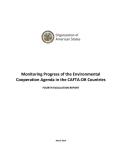
Since 2005, the United States has invested approximately US$ 87.2 million to fund the Central America-Dominican Republic-United States Free Trade Agreement (CAFTA-DR) environmental cooperation. This funding is helping CAFTA-DR countries advance in the following four programmatic areas: (A) Institutional Strengthening for Effective Implementation and Enforcement of Environmental Laws; (B) Biodiversity and Conservation; (C) Market-based Conservation; and (D) Improved Private Sector Performance.
In support of these areas, the Environmental Cooperation Agreement (ECA) (Article IV) requires that the Environmental Cooperation Commission (ECC) be responsible for examining and evaluating the cooperation activities under the Agreement. The ECA highlights as well that the ECC must also seek and consider input from relevant international organizations and other stakeholders regarding how best to ensure that it is accurately monitoring progress.
Climate change is increasingly recognised as a global crisis, but solutions have so far focused on scientific and economic options, rather than on the human and gender dimensions. Despite the fact that marginalised and poor people, including women, are affected first and hardest by climate change, evidence indicates that women’s views, needs and participation are excluded from the design and planning of climate change responses, including major policies. Moreover, women are often perceived primarily as victims, and not as equal contributors of knowledge and skills in disaster risk, adaptation and mitigation strategies.
This brief is based on a research project carried out by Practical Action Consulting with support from the Institute of Development Studies, commissioned by and supported by the Climate and Development Knowledge Network (CDKN), to provide evidence on the advantages and challenges of integrating a gender dimension into climate compatible development strategies in urban settings, with a focus on Peru, India and Kenya. Although considerable evidence exists pertaining to rural areas, significant knowledge gaps can be found in relation to climate compatible development and gender in urban areas. The research attempts to respond to the following four questions:
Gender is an important driver of vulnerability to climate risks, and a key factor to consider in developing effective policy responses to climate change and development challenges. In recent years, there have been a number of efforts to support gender equality as part of responses to climate change. However, gaps remain in drawing lessons from such efforts. This is especially true when it comes to understanding how gender relations affect people’s ability to adapt in urban settings. Given the impact that climate change and extreme weather events are having on urban populations around the world, there is a clear need to provide more evidence to inform climate change and development interventions.
This brief is based on a research project carried out by Practical Action Consulting with support from the Institute of Development Studies,commissioned by and supported by the Climate and Development Knowledge Network (CDKN), to provide evidence on the advantages and challenges of integrating a gender dimension into climate compatible development strategies in urban settings, with a focus on Peru, India and Kenya. Although considerable evidence exists pertaining to rural areas, significant knowledge gaps can be found in relation to climate compatible development and gender in urban areas. The research attempts to respond to the following four questions:
